Year: 2020
TBMs For Norwegian Small Hydropower Projects
Small hydroelectric projects, with installed capacity up to 10 megawatts (MW), are a relatively untapped but potentially game-changing source of renewable energy in North America. In Norway, hydro projects are pioneering the use of small diameter TBMs in hard rock. Compared with drill and blast, TBMs offer increased production rates and reduction in cross section, among other benefits. The uniquely designed machines are engineered to take on steep gradients, up to a 45-degree angle in some cases.
Completing Mexico City’s Mixed Ground Mega Tunnel: Emisor Oriente
On May 23, 2019, the last of six 8.93 m diameter EPBs completed excavation at Mexico City’s Túnel Emisor Oriente (TEO), a feat marking the completion of ten years and 62.1 km of tunneling. The TEO is a critically-designated plan to stem severe flooding while boosting wastewater capacity, and is the country’s largest infrastructure project. The six EPB TBMs excavated some of the most complex geology on earth, ranging from abrasive volcanic rock to watery clays.
Project Clear: Efficient Hard Rock Tunneling below St. Louis, Missouri
The Metropolitan St. Louis Water District’s Project Clear is a 28-year program targeting water quality and wastewater capacity throughout St. Louis, MO. The extensive program involves multiple tunnels, including Deer Creek, a 6.3 km long tunnel being bored with the largest TBM ever used in the St. Louis area (6.5 m in diameter). Another tunnel, Jefferson Barracks, is using TBM components that have bored over 40 km of tunnel since 1981.
On the Move: Robbins TBMs Around the World
At any given time Robbins TBMs are operating in dozens of countries around the world at all project stages. Thus far, 2020 has been no exception to the rule: From an icy visit to the world’s northernmost TBM to breakthroughs across the U.S. to a vast hydropower project on the verge of completion in China, we’ve got the latest updates from Robbins tunnels around the globe.
TBM Tunneling Above the Arctic Circle
Robbins engineers paid a visit to what is likely the northernmost TBM ever to operate in the world, at the Salvasskardelva HEPP near Bardufoss, Norway, 68.7 degrees north latitude. Robbins personnel and the contractor, Norsk Grønnkraft , have been braving frigid winter temperatures, ice and snow to excavate the 2.8 km long tunnel with a Main Beam machine at an upward gradient of 5.8 percent. As of the first quarter of 2020 they are nearly two thirds complete. Once breakthrough occurs the machine will be moved to bore a second tunnel 1.3 km long.
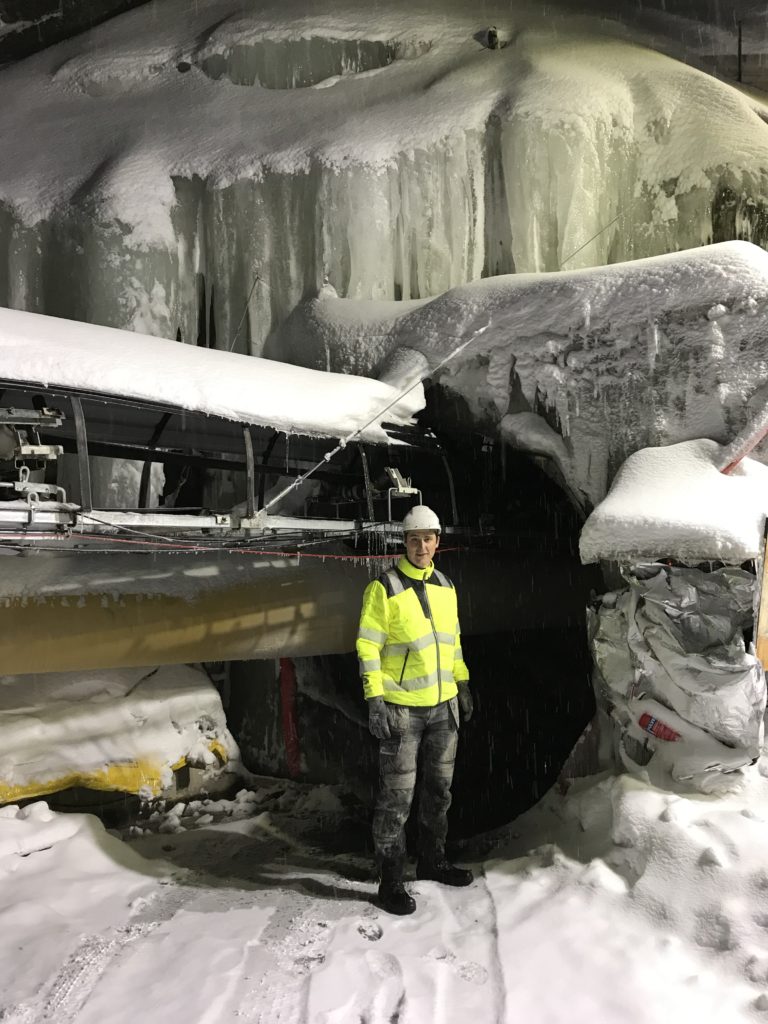
Sindre Log of Robbins Norway visits the wintry jobsite at Salvasskardelva HEPP, possibly the northernmost TBM operation ever.
A Trio of U.S. Tunneling Breakthroughs
Meanwhile in the U.S. multiple machines ranging from 2.2 to 6.5 m in diameter broke through. First up is the Deer Creek Interceptor using a 6.5 m Main Beam TBM and continuous conveyor. The machine holed through on January 29, completing a 6.3 km long tunnel below St. Louis, MO for contractor SAK. Watch this great video from the owner, MSD Project Clear, below.
Also in January, the Turkey Creek Interceptor finished up: a project using a 3.0 m diameter Robbins Double Shield TBM to bore three short drives below Kansas City, MO. Contractor Radmacher Brothers bored a total of 220 m with the machine. Check out the video of the final breakthrough, and image of its first breakthrough several months earlier.

The Turkey Creek TBM, a Robbins Double Shield, during its first breakthrough in Kansas City, MO, USA.
Lastly, in San Antonio, TX a 2.2 m diameter Robbins Double Shield TBM achieved a breakthrough at the SAWS Central Water Integration Pipeline, Segment 5-1. The tunnel, for owner San Antonio Water System, was excavated by contractor Atkinson.
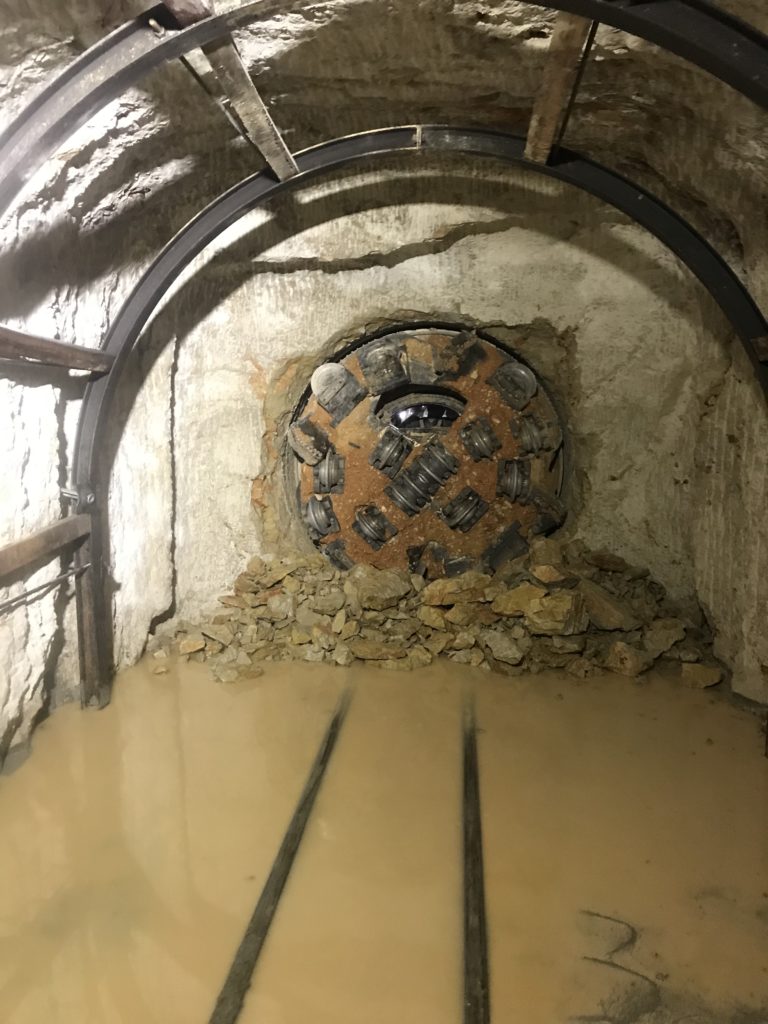
The 2.2 m Robbins Double Shield TBM for the SAWS Central Water Integration Pipeline in Texas.
A Massive Project Nears Completion in China
Two of three long-running Double Shield TBMs have completed their epic drives at China’s Great Hydro Network in Shanxi Province in recent months. The Great Hydro Network sprawls thousands of kilometers and is a feat of engineering. The Robbins machines at Tunnel 2 and Tunnel 4 bored from 15 to 23+ km in length. The machines overcame fault zones, water inflows and karst cavities to forge fast advance rates up to 865 m in one month.
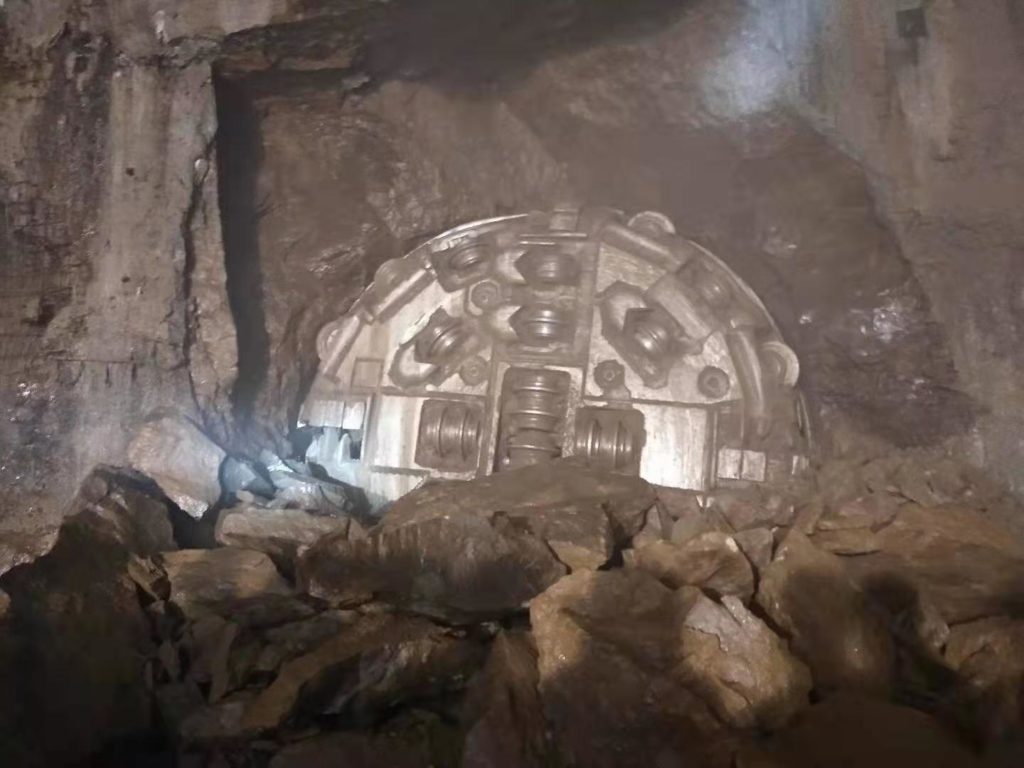
The Robbins Double Shield TBM at Tunnel 4 of the Great Hydro Network.
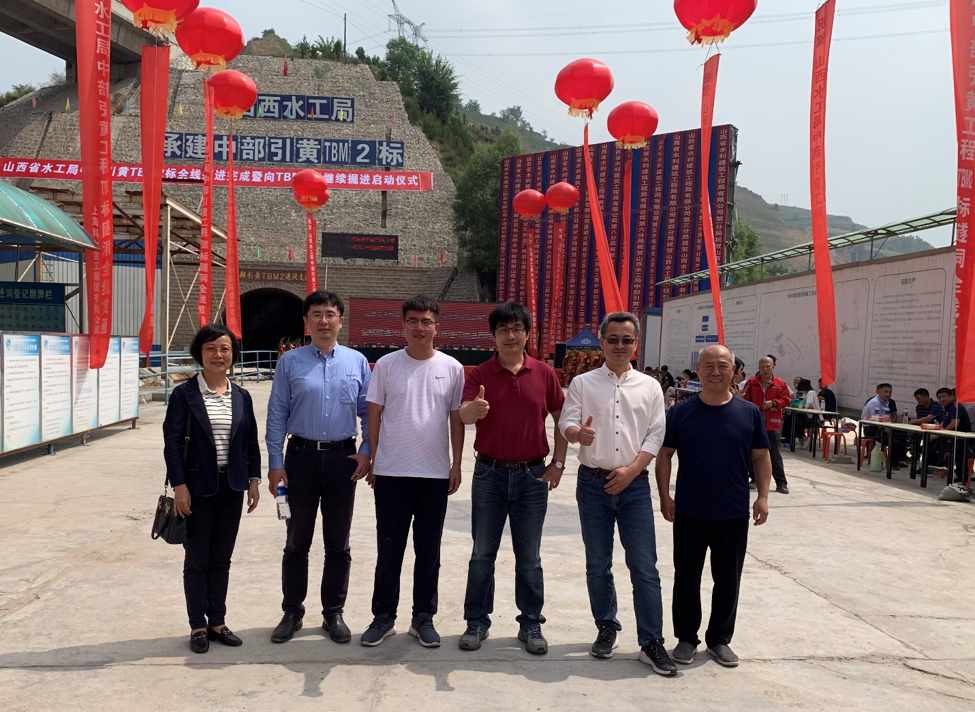
Officials celebrate the breakthrough of the Robbins Double Shield TBM at Tunnel 2 of the Great Hydro Network.
Cutting Edge Virtual Event
Event Name: Cutting Edge Conference
Dates: November 10-11, 2020
Location: Dallas, Texas, USA
Come visit Robbins at the Cutting Edge Conference, now a virtual event, and hear relevant talks on industry hot topics. Learn more about the largest hard rock TBM ever to operate in the USA at the Mill Creek Project. The 11.6 m (38.1 ft) diameter Robbins Main Beam TBM is excavating an 8 km (5 mi) long tunnel in Dallas.
Tune in during the technical sessions as well to find out the latest on tunnel boring machinery for mines, presented by Robbins Chief Engineer Dennis Ofiara:
Tuesday November 10, Session 2 – Innovation in Tunneling
| 1:30 pm MST | The Future of Tunnel Boring for Underground Mines Dennis Ofiara, The Robbins Company |
TAC 2020
Event Name: TAC 2020 Toronto: Vision Underground
Dates: September 28-30, 2020
Location: Toronto, ON, Canada
Come visit Robbins at the Tunnelling Association of Canada (TAC) Conference in Toronto, Canada and hear relevant white papers while getting expert advice and information from our team of experienced staff. Stay tuned for more information on what you can expect to see from Robbins at the show.
Tough TBM breaks through after navigating Faults, Karst, and More
In January 2020, a Robbins 5.97 m (19.6 ft) diameter Main Beam TBM cleared its final hurdle when it broke through in Guangxi Province, China. The TBM excavated its first of two tunnels, an 11.9 km (7.4 mi) long conduit for Lot 1 of the North Line Water Irrigation Project, Letan Water Reservoir, Drought-Relief. The tunnel was marked by a gauntlet of challenges, from karst cavities to fault zones and water inflows. The workers on the jobsite, contractor Guangdong No. 2 Hydropower Bureau Co., Ltd., and the owner, Construction Management Bureau for the Letan Water Reservoir, had much to celebrate after completion of what is widely regarded as the most complex and longest tunnel on the North Line project.
Boring with the Robbins Main Beam TBM and continuous conveyor system began in summer 2015. “There was no precedent in this province for using a Main Beam TBM to excavate a tunnel longer than 10 km. We didn’t have relevant local experience to use for reference,” explained Yongjiu Jin, Deputy Manager of the Project for contractor Guangdong No. 2 Hydropower Bureau Co., Ltd. The machine did encounter a number of difficult geological obstacles as it bored through limestone rock, but was still able to achieve advance rates up to 40 m (130 ft) per day in good ground.
Much of the geology consisted of lightly weathered limestone in rock class II to III, with some sections in class IV to V rock that required the heaviest amount of ground support, ranging from rock bolts to ring beams and mesh. “Our team encountered a coal seam, gasses in the tunnel, two large water inrushes, three fault zones up to 103 m long, 11 karst cavities, and more. In order to solve the ground problems, there were more than 160 special technical research meetings held,” said Yongjiu.
Throughout tunneling, the contractor expressed thanks for Robbins Field Service staff. “Robbins personnel provided good technical support from equipment installation and commissioning through to tunnel completion. After the equipment was handed over to our company, they still helped us with equipment usage on our project, which makes us very satisfied with the Robbins after-sales service. Robbins really delivered: the after-sales phase was not the end of service, but the beginning of site service,” said Yongjiu.
While the completion of the first tunnel—the longest single-heading construction on record for water tunnels in Guangxi—is a milestone, there is more to do. The Robbins machine will be inspected and relaunched to bore a second tunnel 4.2 km (2.6 mi) in length. The ground conditions are predicted to be equally challenging, but the tunneling operation has some help from ground prediction methodology. Tunnel Reflection Tomography (TRT)—consisting of ground prediction using seismic waves—is being used to detect changing conditions ahead of the TBM. The method can predict the distribution and scale of joints and fissures, allowing the crew to plan ahead.
Located near Laibin City, the North Line project provides much needed drought relief using a network of tunnels totaling 29.4 km (18.3 mi). “This tunnel will realize the dream of drought control that people in Central Guangxi have had for many years. The breakthrough is the most important milestone event in this first phase of the North Line project,” said Yongjiu.
Big Data: Innovative Technology to make TBM Tunneling more Efficient
Modern TBMs are data-driven systems, from ground investigation tools ahead of the machine to touch-screen technology in operator’s cabins, to integration with programs on the surface. Today’s TBMs, paired with cutting-edge data collection and monitoring, can efficiently bore in even the most demanding circumstances.
In this complimentary 40-minute webinar, Robbins VP of Operations Steve Chorley and Aaron McClellan, Tunnel Superintendent III for Kiewit Underground, will explore the latest and greatest innovations in technology for TBMs. Nearly all the parameters of a TBM can be monitored today, and this data can be transmitted via radiating coaxial cables to offices on the surface or even mobile phones. Simple observations, such as cutterhead RPM and penetration rate in a given geology, can result in altered operational parameters and reduced thrust that can speed up advance and increase cutter life. All that is required is proactive analysis by management and engineers, and good communication with the TBM operator.
Watch the Recording
What it’s Like to Live at a Jobsite for a Year (or More): An Interview
Debbie Swival, Robbins Field Service Support, is no stranger to tunnel sites. Over her last 12 years at The Robbins Company she has worked on TBMs around the world, from the San Francisco Central Subway to the Moglicë Headrace Tunnel in a remote area of Albania to Turkey’s Bahce-Nurdag High Speed Railway and more. But her longest stay was in Newburgh, NY, USA for the Delaware Aqueduct Repair tunnel.
Swival remained on the jobsite from November 2017 until the TBM’s breakthrough in August 2019—a duration of 21 months. Her role in assisting the crew and troubleshooting issues was integral to the project’s success.
Boring Below the Hudson
The 6.8 m (22.3 ft) diameter Robbins Single Shield TBM for JV contractor Kiewit-Shea Constructors (KSC) bored a total of 3,794 m (12,448 ft) over 582 days with instantaneous penetration rates of 6 m (20 ft) per hour. The unique machine was designed to statically hold up to 20 bar pressure as it bored below the Hudson River to repair a section of the Delaware Aqueduct, the world’s longest continuous tunnel (137 km/85 mi long).
The New York City Department of Environmental Protection (NYCDEP), project owner, discovered that a section of the aqueduct below the Hudson River was leaking up to 75 million liters (20 million gallons) of water per day. On average the aqueduct—built in the 1930s and 1940s—supplies about 50 percent of the water consumed by 8.6 million residents of New York City and an additional 1 million residents in four counties north of the City. A swift repair of the tunnel section was essential.
The tunnel depth—ranging from nearly 270 m (900 ft) deep where the TBM was launched in Newburgh, New York to over 180 m (600 ft) deep at the exit shaft—the water volume, and pressure were all challenges. Probe drilling was mandatory ahead of the TBM and required the use of down-the-hole water hammers for accurate boring under pressure.
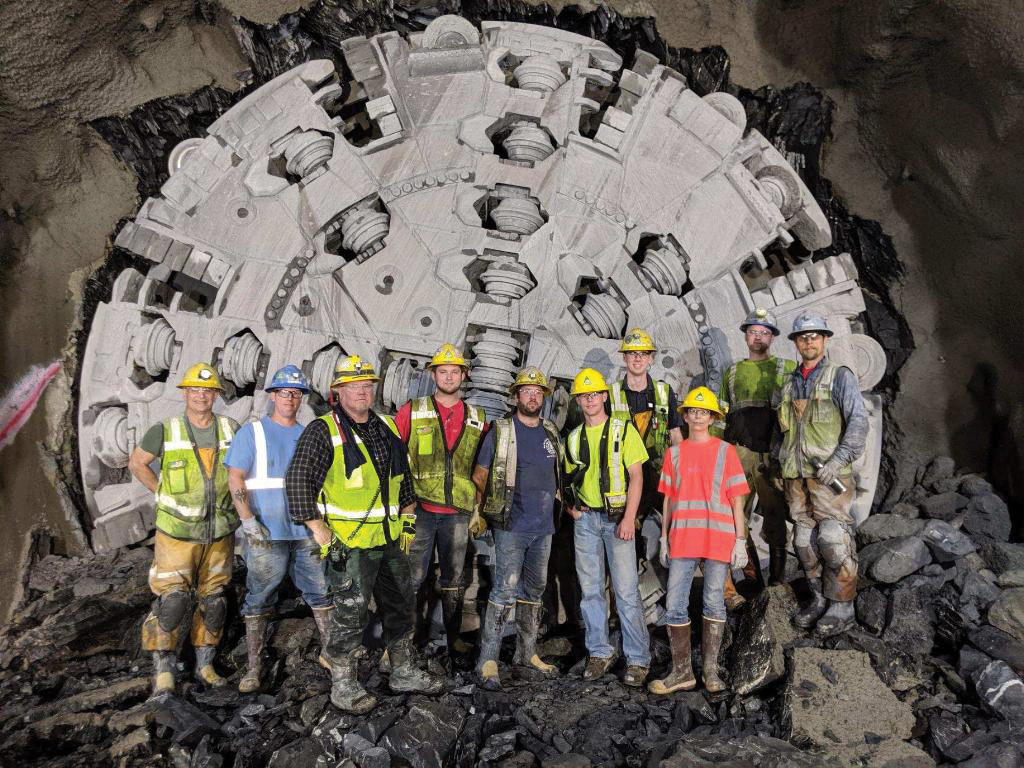
Debbie Swival, third from right, of Robbins Field Service, stayed on the Delaware Aqueduct Repair jobsite for a total of 21 months to keep the machine running smoothly.
What was it like to be at the jobsite for 21 months?
Swival: Being on site for that long was a fantastic experience. I typically stay on a jobsite for 6 to 8 weeks so I do not see the machine in full production. Staying for the boring of the length of tunnel allowed me to see the way that the machine is actually used, as opposed to the theoretical understanding of how different operations should be done. This has given me new insight for programming the machines to better meet the customer’s needs.
Being there for that long also gave the opportunity to create a strong working relationship with the customer. I was part of the team, with everyone working together to get the job done safely and successfully.
What were your main roles at the jobsite?
Swival: Initially I worked with the crew on the machine’s electrical systems and PLC (Programmable Logic Controller) programming changes. Other members of Robbins Field Service conducted training on hydraulics and machine operation. We had three operators at the jobsite who needed training, so I also spent time afterwards reinforcing that training they received. Much of it was on-the-job style training.
As the job continued my role shifted to supporting the machine for any issues that came up. I assisted with troubleshooting hydraulic and mechanical issues as well as continuing to work with the electricians for any problems that arose there. I worked with the customer to implement changes that they requested to the PLC program and to the HMI (Human Machine Interface) screens. I also assisted the customer with interfacing with Robbins engineering to obtain information that they needed.
What was a typical day at the jobsite like for you?
Swival: My typical day started with a 7:30 am meeting with the engineers and supervisors to go over the plan for the day and address any technical issues that had occurred since the previous day. At 8:00 am, a quick safety meeting with the crew, then head to the cage where we all got to be up close and personal during the 6-1/2 minute ride down the shaft. Once at the bottom we got on the mantrip to ride in to the machine. Near the end of the drive it took around 20 minutes to get to the TBM.
Once in the machine, it was time to tie in with the night shift for information on what had happened during the night and where they were in the mining process. At that point it was time to start troubleshooting any problems that had occurred. If all was well I went through and checked the machine for any signs of something getting ready to fail such as wear marks on hoses or cables, low tank levels, loose mounting on sensors and other things that could be fixed before they broke and caused an issue. I spoke with the mechanics and operators to see if there was anything they needed assistance with and also got feedback from them on what they liked as well as what could have been done differently to make their job more efficient.
Conditions in the tunnel were as you would expect – loud and dirty, although there were only a few times when dust was an issue and respirators needed to be worn. The crew often said it was hot in the tunnel, but I love the heat so I didn’t really notice it. We ate lunch on the machine. Since we did not leave the tunnel until the next shift came in, something that is normally overlooked is the need for the crew to relieve themselves. On this machine there was a really nice toilet that was kept cleaned, which made life there so much better! Around 4:30 pm “Mantrip coming in!” was announced over the mine phones as the next shift started their way in to relieve us. We got back to the surface a little after 5 pm and it was so nice to be back in the fresh air!
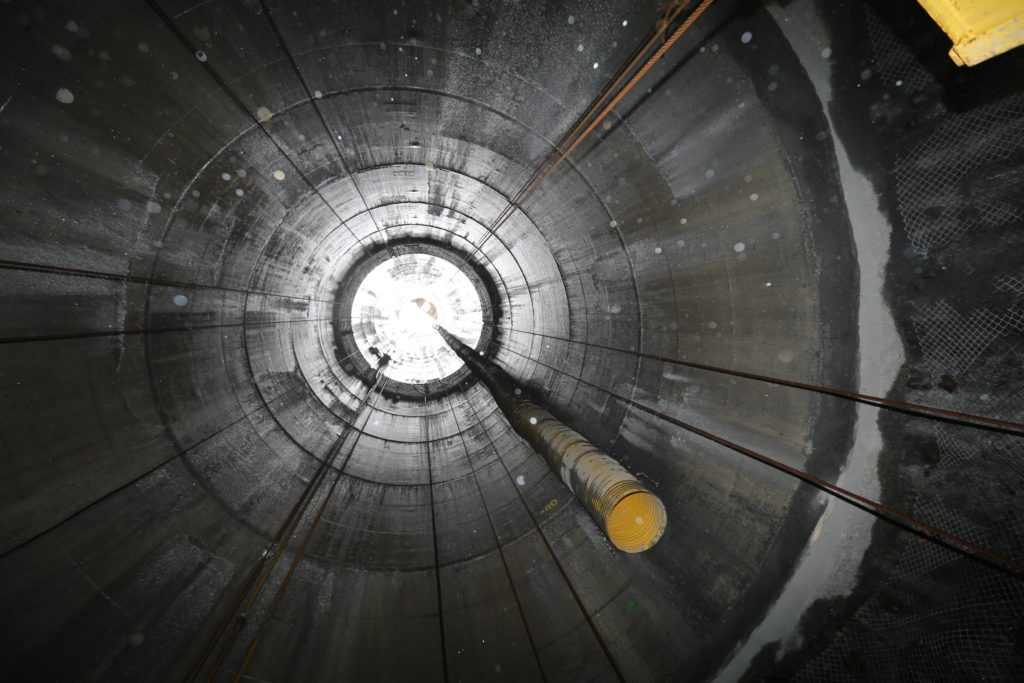
A view looking up from the bottom of the 270 m (900 ft) deep launch shaft in Newburgh. Photo: NYCDEP (www.nyc.gov/dep)
How important are knowledgeable field service personnel for the success of a project?
Swival: It’s absolutely imperative to have knowledgeable personnel. At the Delaware Aqueduct site they had me there because I knew the equipment well and could solve problems quickly. For example, it’s beneficial to have a PLC person on site because it’s a specialized piece of equipment. Although after commissioning there are not many problems with the PLC, when there is an issue it requires the code to be changed. Some PLC hardware failures or changes can also require that the program is modified. When an electrical or hydraulic issue occurs on the machine, I can use the program as a troubleshooting tool, find out what physical device isn’t working then describe the problem to the crew and educate them on how to fix it. This shortens downtime from 12 hours for a crew without PLC personnel on site, to around two hours.
What are some other examples of challenges that you were able to overcome at the site?
Swival: I helped to optimize the boring parameters, such as reducing thrust pressure, adjusting ring build procedures, and fine-tuning articulation cylinder pressure to avoid downtime and keep the machine moving. There was a section of the tunnel where the rock transitioned from shale to granite, and the difference in rock strength meant we had to set new limits for the thrust pressure to extend the life of the disc cutters.
There was an issue with the segment unloaders where the forward unloader was in the lowered position and the rear unloader was raised. The setup didn’t provide any clearance for when the train moved out. Typical sensors were not able to be mounted in the location. I worked with the mechanical team to find a solution for sensing the positions of the unloaders and prevent this from happening in the future. Lights were added to give a visual indication to the operator of the fully raised and lowered positions, and I changed the logic to incorporate the modifications. Those are just a few examples of what I helped with.
What is your favorite memory from the project?
Swival: It was amazing to be able to climb through the hole in the cutterhead and stand in front of the machine when it broke through. The support from everybody throughout the project was incredible. Everyone worked together, and the level of community on the job was exceptional. It was simply a great place to work.
Video courtesy of NYCDEP (www.nyc.gov/dep).
For more on the unique tunneling operation at the Delaware Aqueduct Repair, check out these resources:
White paper: https://www.robbinstbm.com/managing-high-water-inflows-2/
Press release: https://www.robbinstbm.com/delaware-aqueduct-repair-breakthrough/
Robbins unveils Largest Hard Rock TBM in the U.S. at Mill Creek
In December 2019, the City of Dallas, Texas, USA unveiled the largest hard rock TBM ever to bore in the U.S. The 11.6 m (38.1 ft) diameter Robbins Main Beam TBM will excavate the 8 km (5 mi) Mill Creek Drainage Relief tunnel, and its size is not its only distinction. The adaptable machine will change size partway through the bore, to a more compact 9.9 m (32.5 ft).
The unique Robbins TBM will be used to dig a tunnel designed to provide 100-year flood protection for east and southeast Dallas, areas affected in recent years by severe storms. The tunnel will protect 2,200 commercial and residential properties, including Baylor Medical Center. The current drainage system in these areas was constructed 50 to 70 years ago, and only provides two to five years of flood protection. “The completion of the TBM assembly marks a major milestone in the Mill Creek Tunnel Project,” said Council Member Lee Kleinman, chair of the Transportation and Infrastructure Committee for the City of Dallas. “I’m thrilled to see this type of engineering marvel happening right here in Dallas.”
The dual-diameter aspect of the Robbins TBM will be a first-of-its-kind conversion process. The contractor, Southland/Mole Joint Venture (SMJV), will make the conversion underground about 2.8 km (1.8 mi) into the bore. The two diameters are needed as the upstream section of the tunnel is designed with a circular cross section and peak flow rate of 42 m3/sec (15,000 ft3/sec), while the downstream 2.8 km (1.8 mi) portion has a higher peak flow of 565 m3/sec (20,000 ft3/sec) and was initially designed as a horseshoe cross section. Using the TBM for the entire tunnel is less time consuming and costly. “Robbins and SMJV are working closely to create the safest and most efficient sequence for completing this conversion within the limits of the bore. The City of Dallas (Owner) and our Project Team are very excited to embark on this unique challenge,” said Nick Jencopale, Project Manager for Southland Holdings.
The Robbins TBM, named “Big Tex” with permission of the State Fair of Texas, has been designed with a specialized cutterhead including removable spacers and adjustable bucket lips to convert to a smaller diameter. The TBM will first complete its 11.6 m (38.1 ft) diameter section of the alignment, then back up about 21 m (75 ft) to a transition area for the conversion, which is expected to take six to eight weeks.
As the TBM bores, it will pass through Austin Chalk between 12 to 30 MPa (1,800 to 4,400 at depths from 31 to 46 m (100 to 150 ft) below the city. The route is potentially gassy, so probe drilling is mandatory throughout the project. Crews will utilize ground support including eight 3.9 m (13 ft) long rock bolts every 1.5m (5 ft) with wire mesh and channel straps as needed. The finished tunnel will be lined with a 380 mm (15 in) thick cast-in-place concrete lining.
“Big Tex will work 24 hours a day to excavate the tunnel with crews ranging in size depending on activities,” said Rachel Sackett, marketing and communications director for Southland Holdings. Based on previous work through similar geology, the project team expects TBM excavation to progress rapidly to an average of 25m (80 ft) per day, allowing the project to be completed on schedule in 2023.

 Close
Close  Menu
Menu 